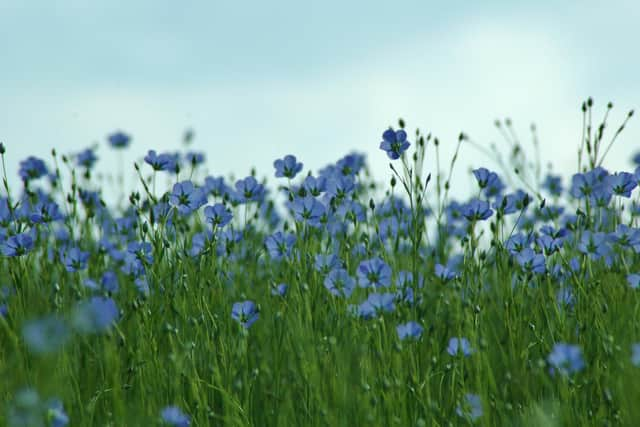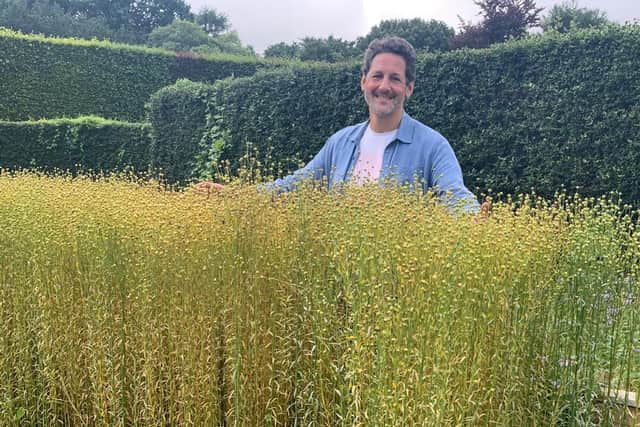Blue flowers of flax planted to mark festival of Scotland's 'first industry'
and live on Freeview channel 276
This month the first Festival of Flax and Linen will acknowledge the powerful growth of the spinning and weaving of the crop that developed from a small craft enterprise to a major industry that connected Scotland to Europe and then the world.
The festival will be rooted in Fife, where evidence of flax growing stems back to the Bronze Age and where the region’s last linen mill closed in Kirkcaldy in April. Dunfermline will be forever linked to the fine damask tableware spun for generations.


Advertisement
Hide AdAdvertisement
Hide AdEvents will also be held in Ceres, Falkland, Strathmiglo, Markinch, Auchtertool and Burntisland, as well as Inverkeithing and Silverburn Park in Leven, where work is underway to transform an old mill into a museum and visitor centre to illuminate this long and powerful chapter in Scotland’s industrial heritage.
Pockets of flax have been planted all over the Kingdom to mark the event.
Dr John Ennis, director of the festival and curator of Journeys in Design, said: “When people think of Scottish textiles it’s often tartans, tweeds and Paisley shawls that spring to mind, but linen should be up there too.
"Its role in the story of Scotland was huge, but it’s slipping out of history and at risk of being forgotten. Fife was at the heart of all that: flax and linen once played a huge part in the landscape, prosperity and culture of the Kingdom.”


Advertisement
Hide AdAdvertisement
Hide AdHe added: "The flax and linen trade was a vital part of what made Scotland. It was the country’s first state-supported industry and tells the story of our nation.”
The festival’s main exhibition will be in the former Stocks Linen Mill in Linktown, Kirkcaldy – now Stocks Carpets – where there will be an exhibition of artefacts, stories and contemporary designs in flax fibre and linen from Scotland and beyond.
The future of flax will be covered in an online event that will include contributions from Belgium, the Netherlands, France, Austria and the USA.
Scotland’s industrial-scale flax story began with creation of the Board of Trustees for Fisheries and Manufacturers, which was formed following the 1707 Union to promote economic growth.
Advertisement
Hide AdAdvertisement
Hide AdThe board brought Huguenot weaving expertise from France to Edinburgh, sponsored schools of weaving and connected designers with manufacturers.
Scotland once grew enough flax to support its industry, but ports in the east of the country drew in cheap imports from the Baltic, with crops arriving from Russia, Germany and the Netherlands.
The first cargo came into Dundee in 1791 and 100 years later, around 50,000 tonnes of flax was arriving in Scotland for weaving.
Scotland was known for its coarser and rougher linen with the bulk of canvas required for the sails of Royal Navy vessels made here, with contracts also signed with the US Navy.
Advertisement
Hide AdAdvertisement
Hide AdAround 25 per cent of linen exports were going to North America by the end of the 18th century, with 62 per cent dispatched to the West Indies.
Full details of the festival can be found at wwwjourneysindesign.com with tickets for free events bookable on Eventbrite.
A message from the Editor:Thank you for reading this article. We're more reliant on your support than ever as the shift in consumer habits brought about by Coronavirus impacts our advertisers.
If you haven't already, please consider supporting our trusted, fact-checked journalism by taking out a digital subscription.
Comment Guidelines
National World encourages reader discussion on our stories. User feedback, insights and back-and-forth exchanges add a rich layer of context to reporting. Please review our Community Guidelines before commenting.
